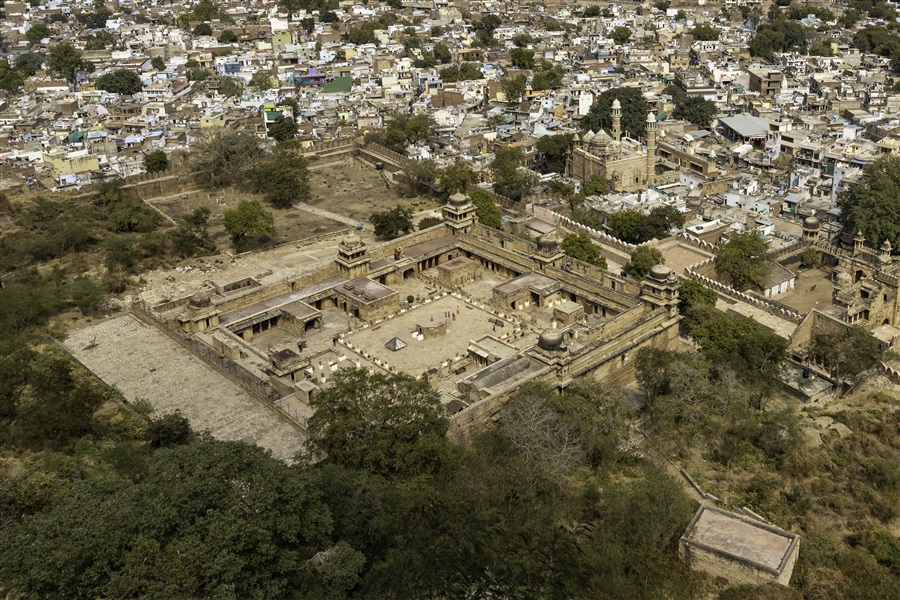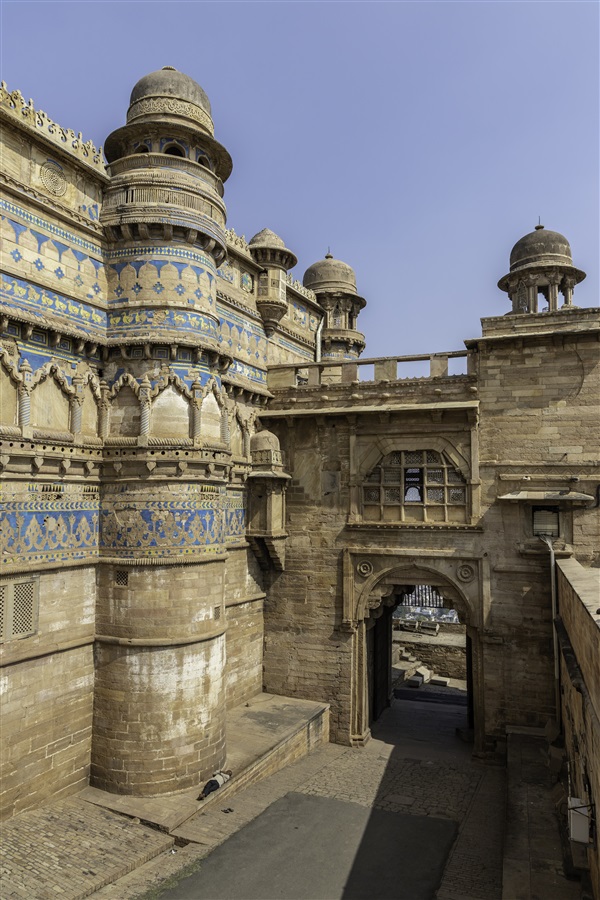In addition to the main monuments to see up at Gwalior Fort, there are a number of far less frequently visited structures that I briefly explored during my time here. None of these warrant a separate blog, so I have clubbed them together in this post.
Here’s the full list of the main monuments in and around the fort that are covered elsewhere, just click on the links below :
- Man Singh Palace
- Sas Bahu Temple
- Teli Ka Mandir
- The Rock-cut Jain Monuments (there are many!)
- Chaturbhuj Temple – and the famous “Zero”
- Gurdwara Data Bandi Chor Sahib
- ASI Archaeological Museum
- Gujari Mahal State Archaeological Museum
There’s also the Tombs of Mohammad Ghaus and Tansen that are less than 1 km away from the fort.
Just north of the Man Singh Palace are a number of deserted palaces, less interesting than the Man Singh Palace but covering a much larger area. You need purchase a separate ticket to see these structures.
Rather frustratingly these palaces have a number of different names used by guides and historians, most were built in the 15th and 16th centuries by the Tomar dynasty and subsequently altered and added to by the Mughals.
Karan Mahal

Also known as the Kirti Mandir, the Karen Mandir was built between 1454 and 1479 by the second King of the Tomar dynasty, Kirti Singh. It lies opposite Dhonda Gate.




It’s a long double-storeyed building with one large room and two smaller rooms either side. Inside are traces of paint, and some remains of tile decoration on the outside.
Vikram Mahal


Built in 1516 by Vikramaditya Singh (the eldest son of Man Singh), this lies between the Man Singh Palace and the Karan Mahal. Hidden in the walls is a secret passage that used to connect this Mahal with the Man Singh and Karen Mahal. This was for a time converted into a Shiva temple.
Chhatri of Maharaja Bhim Singh Rana and Jauhar Kund

This is a memorial tower for Maharaja Bhim Singh Rana, a ruler of Gohad who briefly occupied Gwalior Fort from 1740 to 1755. He died due to wounds he received in a battle with the Marathas at Saloo, near Gwalior Fort, in 1755.



In front of the Chhatri is a large square tank, called Jauhar Kund. It is thought that here the women of the fortress committed Jauhar, or mass self-immolation, when the forces of the Delhi Sultanate conquered Gwalior in the 13th century.
Jahangir Mahal and Shah Jahan Mahal

These two quite extensive palaces offer some great views from the side of the hill across to Gwalior’s old city, looking down on the Jama Masjid and Gujari Mahal.









That concludes the structures you can see north of the Man Singh Palace, the remaining structures are dotted around Gwalior hill.
Assi Khamba Baoli

This is often overlooked by visitors because there’s no obvious entry to it, which is to the right as you look at the building.

As the name suggests, this is a large circular step-well protected by wall with a pavilion to one side. Some of the columns seem to have traces of red paint.



Most step-wells in India have flights of stairs leading down to the water in the open air, that is, on the sides of the well itself. At Assi Khamba Baoli it appears that access is via an enclosed staircase leading down to the bottom. Access to this staircase is no longer permitted.
Hindola Gate

This is one of the main gates to Gwalior Fort from the eastern entrance, it is located at the foot of the hill next to Gujari Mahal.
Built in the 15th century but restored in 1648, this gate is largely contemporary and shares the same architecture as the Man Singh Palace. A swing, or hindol, once existed outside.

The Gate is also known as Badalgarh, named after Man Singh’s uncle, Badal Singh.
Jain and Hindu Shrines

Halfway up your climb to Gwalior Fort from the eastern approach are a number of small Jain and Hindu shrines carved into the hillside on your right.




If the small Jain shrine (the human figure) grabs your attention, there are far more impressive Jain monuments to see elsewhere carved into the face of this hill.
Lakshman Gate


This gate is closest to the above rock-cut shrines halfway up the eastern approach to the fort, not far from the famous Chaturbhuj Temple.
Although mostly plain and certainly not as grand as some of the other fort gates, it does have some interesting carvings incorporated into the structure.
Hathia Paur Gate


Built sometime between 1486 and 1516, this is the last of the gates you pass through as you approach the fort from the east. It forms part of the Man Singh Palace, a further gate (Hawa Gate) no longer exists.
Suraj Kund


This is located close to Teli Ka Mandir, and is the earliest tank on the hill. It is here that legend says Gwalior was initially founded, you can more about that story in my post about the Man Singh Palace.
Please ‘Like’ or add a comment if you enjoyed this blog post. If you’d like to be notified of any new content, just sign up by clicking the ‘Follow’ button. If you have enjoyed this or any other of my posts, please consider buying me a coffee. There’s a facility to do so on the righthand side of this website for desktop users, and just above the comment section for mobile users. Thank you !
If you’re interested in using any of my photography or articles please get in touch. I’m also available for any freelance work worldwide, my duffel bag is always packed ready to go…
KevinStandage1@gmail.com
kevinstandagephotography.wordpress.com
Categories: Gwalior, Gwalior Fort, Gwalior Fort - Other Monuments, India, Madhya Pradesh




